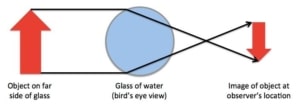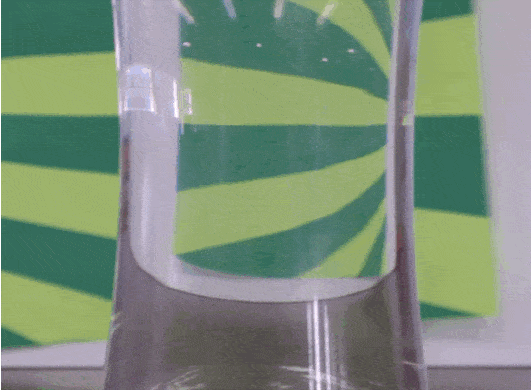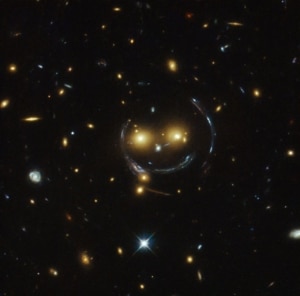
Ever tried burning wood or pine needles with a magnifying glass? It works best when you adjust the glass to create a small, bright spot of light. After its 93-million-mile journey to Earth, sunlight isn’t ordinarily hot enough to start a fire, but the magnifying lens focuses a large cross-section of light rays into a single intense point. This kind of lens is called convex.

A glass of water is essentially a convex lens. Just like sunlight passing through a magnifying glass, an image traveling through a cylinder of water is focused into a single spot some distance away. The rays don’t stop there, and as they continue, their paths cross. The part of the image that started on the right ends up on the left, and vice versa!

This is an easy trick to try at home! All you need is a clear glass or jar and an image to flip. If you don’t see the expected results right away, try putting more distance between yourself and the glass– the image will only appear backwards if you’re past the point where the rays of light meet and cross.

A cool astronomical tidbit: Another thing that bends light is gravity. This allows it to focus light as well, and sometimes Earth will be on the receiving end of this. Unlike the fire starting focused sunlight, this is a useful tool that allows scientists to locate black holes and get unique views of faraway objects and is known as gravitational lensing. For a better understanding, check out the animation below:

Video Source: https://www.eso.org/public/videos/eso1522a/
The ring-like structure of the galaxy in the picture is actually quite common in space. Scientists can’t control when they can see or use gravitational lensing as it is the result of the positions of objects that are very far away, but these serendipitous events allow us to learn more about both of the objects involved!


Two gravitational lensing examples captured by Hubble. On the top is a nearly complete Einstein ring. On the bottom, the lensing alignment is slightly off, smearing the images of the distant galaxies to form a friendly smiley face!
Credit: NASA/ESA/Hubble
